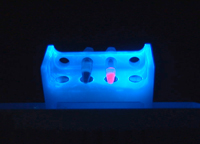Tokyo Institute of Technology's Hiroshi Handa trained as a physician and after a post-doc at MIT decided to pursue basic research instead of practicing medicine.
Handa is focused on four research areas: (1) regulation of transcription elongation; (2) chemical biology based on drug target identification; (3) high-performance magnetic beads; and (4) highly functionalized nano-capsules formed by viral capsid protein.
Here, Handa describes his research on the development of high-performance magnetic beads –FG beads– for biomedical applications and affinity screening. The surfaces of the 140 nm-diameter FG beads are functionalized to enable the immobilization of DNA, proteins, and chemical compounds including drugs for one-step affinity purification of targets directly from libraries with high purity and high recovery.
"This is an innovative technology which makes the impossible a real possibility," says Handa. "We have developed several types of magnetic beads with multi-functions, such as fluorescence-FG beads and ferrite-containing nanocapsules for medical applications."
The magnetic beads enabled Handa and his colleagues to discover novel transcription elongation factors (DSIF and NELF) which affect RNA polymerase II transcription elongation, and elucidate the mechanism of promoter-proximal pausing. Furthermore, the identification of drug targets provides an insight into the action of drugs and the regulation of biological reactions due to the drugs.
"We have also searched the target of thalidomide, which went off the market about fifty years and then returned to the market as anti-cancer and anti- inflammatory drugs about ten years ago, "says Handa. "We identified cereblon as the target of thalidomide teratogenicity and found that cereblon forms an E3 ubiquitin ligase complex, involved in the outgrowth of limbs and ears. We also discovered that thalidomide initiates its teratogenic effects by binding to cereblon and inhibiting the associated ubiquitin ligase activity."
This pioneering research revealed the basis of thalidomide teratogenicity and may contribute to the development of new drugs without teratogenic effects. Recently, in collaboration with the US pharmaceutical industry, Handa's group discovered that cereblon is also involved in the therapeutic effects of thalidomide.
The affinity bead technology developed by Handa at Tokyo Institute of Technology will play an important role in the development of chemical biology and drugs. FG beads are commercially available from Tamagawa Seiki Co. and are being increasing used overseas.
"We are undertaking joint research with a pharmaceutical company in the US," says Handa. "We will work towards practical use of nanocapsules with corresponding epitopes as vaccine preparation against cancer and viral diseases in collaboration with industries."
Further information
. Any information published on this site will be valid in relation to Science Tokyo.




